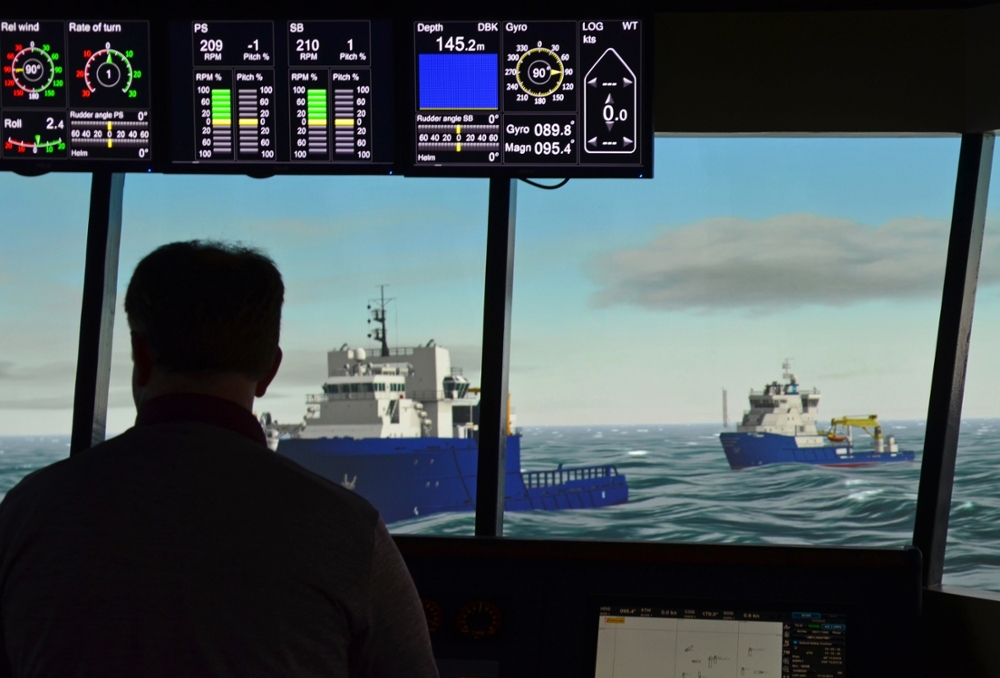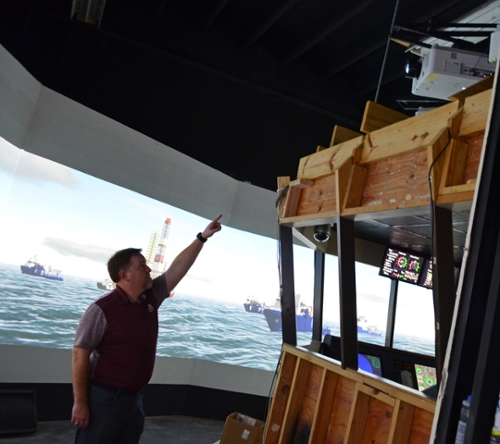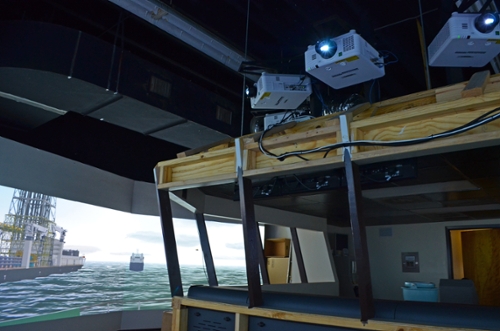$81,000 of New Equipment Will Pay Dividends in Ship Simulator Training
August 9, 2019
Tweet
Texas A&M University at Galveston Campus Technical Lab Coordinator Patrick Zimmer demonstrates an exercise in the full-bridge ship simulator after new projectors were installed, greatly enhancing the resolution and overall experience for Texas A&M Maritime Academy cadets as they learn ship-handling drills and maneuvers.
By Andréa Bolt, Marketing and Communications
“It’s like going from a 25-inch tube TV to a 4K flat screen,” says Technical Lab Coordinator Patrick Zimmer when describing the $81,000 worth of new projectors installed in the ship bridge simulator.
Zimmer says the projectors enhance the screen to be three times brighter than before, allowing cadets utilizing the simulator to gain a greater understanding of various ports they could potentially visit and providing better clarity to lead to better training overall.
The full-mission bridge simulator is a crucial, and expensive, part of the training Texas A&M Maritime Academy cadets receive. Several spaces housed in an unassuming building on the Galveston Campus utilize cutting edge technology to provide cadets invaluable training to prepare them for any number of maritime situations and condition, the bridge simulator being the largest and most technologically-advanced.
The old projectors used a 4:3 projection ratio, similar to a lot of early 00s computer monitors.
“We went to a 16:9 projection ratio, which increased details by orders of magnitude. It looks great and will allow us to provide a much more realistic training environment for students using this new system,” Zimmer said.
To purchase, install and calibrate seven projectors, cost approximately $81,000. The resulting display has a significantly crisper, brighter picture. Rolling, pitching waves now have incredibly realistic whitecaps, rain splashes across the bridge windshield and even the northern lights are visible over Alaska’s Prince William Sound in their undulating green glory.
“When their simulator experience is as realistic as possible, it benefits them, it benefits the companies they go to work for, it benefits the A&M brand and the quality of mariners we’re putting out, and it benefits consumers and society. Our graduates will be helping to maintain and expand the global supply chain. Globalization is only increasing, which is another great part of this training – we can train them using real scenarios in accurately reproduced ports,” explained Zimmer.
There are major ports the cadets are trained on in the simulator, including Houston/Galveston, the English Channel, Singapore and the Straits of Malacca, the Straits of Hormuz, Alaska, San Francisco, Seattle/Tacoma, ports on the East Coast and more.
“All of the locations we choose for training are there for commercial purposes, they’re not just screen or eye candy, though they now look that way,” Zimmer quipped.
Cadets learn to manage people and ships every semester they are enrolled at the Texas A&M Maritime Academy. They learn the art of ship handling, how to respond to various mechanical and electronic systems failures they will inevitably experience and they are required to interact professionally and competently with their peers no matter what they experience.
“Every cadet is a firefighter and learns how to engage in damage control. Every cadet works in food preparation and engages in shipboard cleaning. Every cadet does maintenance and stands a watch,” he said. “The little things they do every day contribute to the health and morale of the entire crew and vessel."
Summer sea term is about more than cadets getting their sea legs and getting away from campus, it's about diving headfirst into a living laboratory of systems and people with real-life consequences and learning to become very detail-oriented in everything they do. The lessons they learn from the cruise will make them better mariners and the friendships they forge will make them better Aggies.
Above: Texas A&M University at Galveston Campus Technical Lab Coordinator Patrick Zimmer points to the new projectors installed in the full-bridge ship simulator, greatly enhancing the resolution and overall experience for Texas A&M Maritime Academy cadets as they learn ship-handling drills and maneuvers.
Above: New projectors were recently installed in the Texas A&M University at Galveston’s full-bridge ship simulator, greatly enhancing the resolution and overall experience for Texas A&M Maritime Academy cadets as they learn ship-handling drills and maneuvers.
###
Media contact:Communications Specialist
a_bolt@tamug.edu
More:
Science & Technology
Marine Engineering Technology
Maritime Transportation
Texas A&M Maritime Academy


